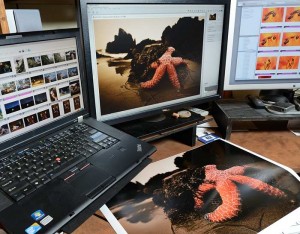One of the challenges of color management the past few years has been the brightness of LCD monitors. Most people like them bright and contrasty, and the manufacturers have heard their wishes and complied. For those of us serious about color management, that’s created a problem.
There are two key parts to color management when it comes to monitors – calibrating the monitor and then profiling it. That requires both a piece of hardware (colorimeter or spectrophotometer) and a piece of software working together. The profile that’s created as the final step is what translates the color and tonal range in your photo into an accurate view on your monitor. However, if the first step, calibrating, doesn’t happen correctly, then the profile won’t be very accurate. And those bright monitors can make accurate calibration tough, if not impossible.
The problem is that most monitors, being built to be extremely bright, can’t be turned down dim enough to properly calibrate. The end result is that even if a photographer does everything right creating the profile, their images print too dark, since they’re unable to set the luminance of the monitor low enough. A common work-around for this has been to go into the Red, Green and Blue controls in the monitor and dial them back from their default setting, 100%, to 50%. That results in a dimmer display and allows you to calibrate the monitor properly before profiling.
Not all monitors have suffered from this. Some of the more expensive ones, particularly those designed for the graphics or photo industry, can be set properly. But most monitors haven’t allowed that. At least until now.
After four years of steady use, my Dell 24-inch monitor was showing uneven tone across the screen. With just a gray desktop, the center was noticeably darker than the edges. Time for a replacement. Being cheap, I wasn’t willing to spend over $1000 for one of those pricey monitors I mentioned above. However, doing a bit of research, it sounded like the newer generation of my Dell would work well for what I wanted, for around $500. Got it and hooked it up to my main image processing computer, a Lenovo ThinkPad W510.
I still expected to have to dial down the R,G and B channels, just as I did on the older one. But first I thought I’d give it a try just the way it was. Eureka! I was able to calibrate the luminance to the proper level without changing the default RGB values, using my favorite color management package, the X-Rite ColorMunki. And after profiling, it was a very close match to the prints I started making with my Epson 4800 printer. It may not be possible to take a backlit RGB image and get that exact same look on paper with the inks we have today, but you should be able to get close. And this sure did.
Does this mean all monitors will calibrate properly now? I doubt it. But I’m hopeful that more of them will, and that in time it will be easier to find ones that do. We’ve seen some great advances in the technology supporting photography over the last decade, and I’m hopeful that more, like this, are coming.

